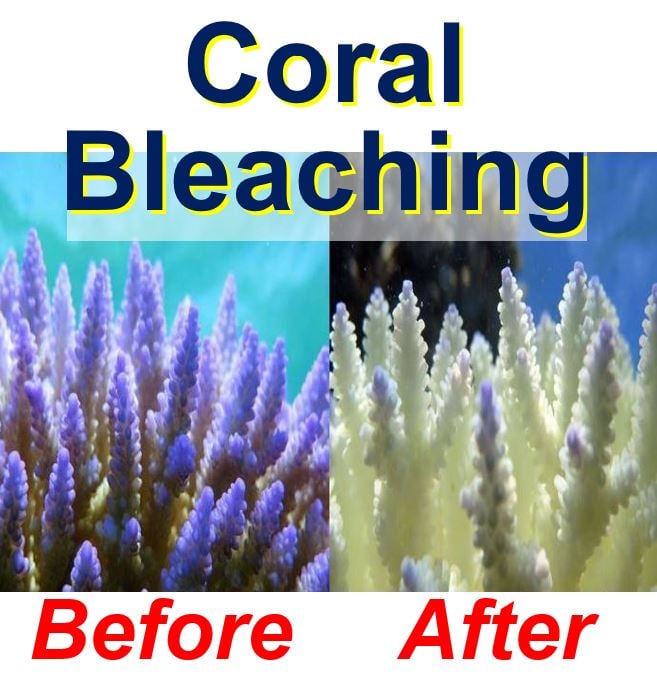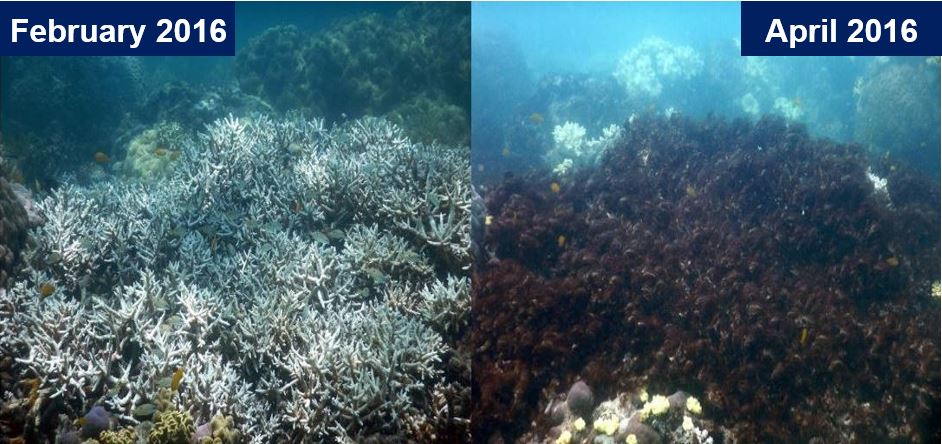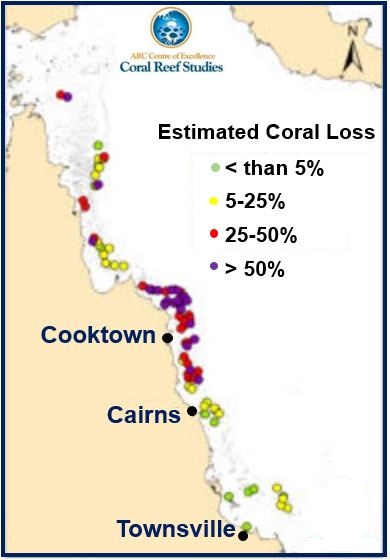Mass bleaching has killed over one third – 35% – of the corals on the central and northern Great Barrier Reef, says a team of Australian scientists from ARC Centre of Excellence for Coral Reed Studies.
After several months of intensive underwater and aerial surveys, scientists have released a preliminary estimate of the death toll resulting from coral bleaching.
Coral bleaching occurs when certain environmental conditions, including higher sea temperatures, cause corals to expel zooxanthellae – tiny photosynthetic algae.
 An example of coral bleaching. If the water temperature returns to normal fast enough, there is a chance the coral can make a full recovery – otherwise it most likely dies. (Image: James Cook University)
An example of coral bleaching. If the water temperature returns to normal fast enough, there is a chance the coral can make a full recovery – otherwise it most likely dies. (Image: James Cook University)
When concentrations of these algae decline below a certain level, the corals bleach, i.e. they turn white.
If temperatures drop again and zooxanthellae can recolonize the corals, there is a chance they may recover, otherwise they will most likely die.
The impact of coral bleaching on the Great Barrier Reef is still unfolding, the researchers say. They add that the northern sections are considerably more severely affected than other parts.
Professor Terry Hughes, Director of the ARC Centre of Excellence for Coral Reef Studies at James Cook University (JCU) in Queensland, Australia, said:
“We found on average, that 35% of the corals are now dead or dying on 84 reefs that we surveyed along the northern and central sections of the Great Barrier Reef, between Townsville and Papua New Guinea. Some reefs are in much better shape, especially from Cairns southwards, where the average mortality is estimated at only 5%.”
 Bleached mature staghorn coral in February 2016 at Lizard Island, Great Barrier Reef. By April 2016 it was dead and overgrown by algae. (Image: coralcoe.org.au)
Bleached mature staghorn coral in February 2016 at Lizard Island, Great Barrier Reef. By April 2016 it was dead and overgrown by algae. (Image: coralcoe.org.au)
“This year is the third time in 18 years that the Great Barrier Reef has experienced mass bleaching due to global warming, and the current event is much more extreme than we’ve measured before.”
“These three events have all occurred while global temperatures have risen by just 1 degree C above the pre-industrial period. We’re rapidly running out of time to reduce greenhouse gas emissions.”
Southern section has fared better
Dr. Mia Hoogenboom, who is also from JCU, explained that according to their underwater surveys, in the reefs south of Cairns over ninety-five percent of the corals appear to have survived “and we expect these more mildly bleached corals to regain their normal colour over the next few months.”
Even though considerably fewer corals in the south have died, the stress brought on from bleaching will probably temporarily slow down the speed at which they reproduce and grow.
As water temperatures were closer to normal summer conditions in the southern section of the reef, that area has been spared serious damage, the scientists said.
 Map of mortality estimates on coral reefs along 1100 kilometres of the Great Barrier Reef. (Image: coralcoe.org.au)
Map of mortality estimates on coral reefs along 1100 kilometres of the Great Barrier Reef. (Image: coralcoe.org.au)
Great Coral Reef less resilient than before
Professor John Pandolfi, from the ARC Centre of Excellence for Coral Reef Studies at The University of Queensland, said:
“It is critically important now to bolster the resilience of the Reef, and to maximise its natural capacity to recover. But the reef is no longer as resilient as it once was, and it’s struggling to cope with three bleaching events in just 18 years.”
Several coastal reefs have suffered significant damage. In Western Australia, bleaching has been extensive and patchy, as has mortality.
Dr Verena Schoepf from The University of Western Australia, said:
“On the Kimberley coast where I work, up to 80% of the corals are severely bleached, and at least 15% have died already.”
Over the coming months, the scientists say they plan to re-visit the same reefs to measure the final loss of corals due to bleaching.
The recovery of coral cover will probably take at least ten years, they forecast. It will take considerably longer to regain the largest and oldest corals that have perished.
About 80% of #corals on the #Kimberley coast are severely bleached, at least 15% dead @CoralCoE data shows pic.twitter.com/8JU9n46RrB
— CoralCoE (@CoralCoE) May 30, 2016
Economic importance of the Reef
The Australian Government says that Reef Tourism generates an income of approximately AUD$5 billion each year, and directly provides nearly 70,000 jobs.
The Government adds that climate change (global warming) is the biggest threat to the Great Barrier Reef and the people whose incomes depend on it.
Chief Executive of the Queensland Tourism Industry Council, Daniel Gschwind, said:
“Thankfully, many parts of the reef are still in excellent shape, but we can’t just ignore coral bleaching and hope for a swift recovery. Short-term development policies have to be weighed up against long-term environmental damage, including impacts on the reef from climate change.”
Video – Coral bleaching harming marine life
Watch to see how coral bleaching is endangering the lives of reef fish.
Fatal Attraction: Watch to see how #coral #bleaching is endangering the lives of reef fish #gbr @jcu @MarkIMcComick pic.twitter.com/61lUl8q6xe
— CoralCoE (@CoralCoE) May 13, 2016

